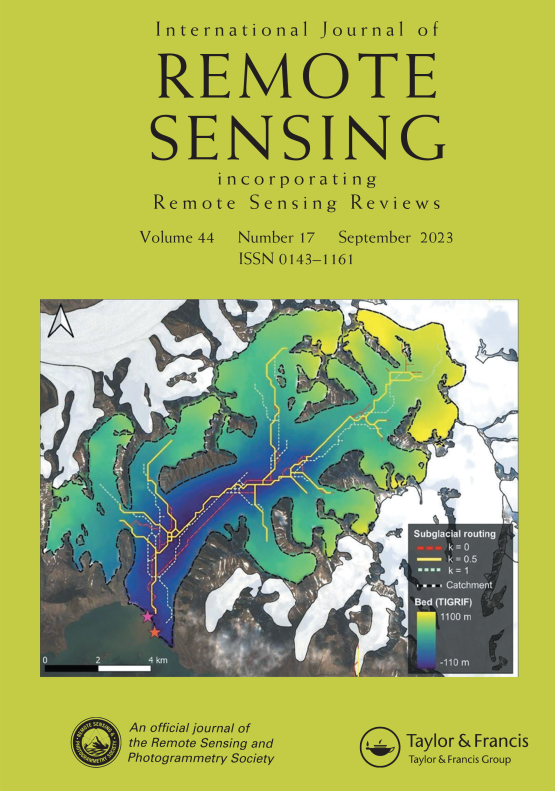Submit a Manuscript to the Journal
International Journal of Remote Sensing
For a Special Issue on
New research from the Spaceborne Imaging Spectrometer Mission DESIS
Manuscript deadline
30 October 2024

Special Issue Editor(s)
Uta Heiden,
German Aerospace Center (DLR)
[email protected]
Daniele Cerra,
German Aerospace Center (DLR)
[email protected]
Rupert Müller,
German Aerospace Center (DLR)
[email protected]
Mary Pagnutti,
Innovative Imaging & Research
[email protected]
New research from the Spaceborne Imaging Spectrometer Mission DESIS
On August 2023, the DLR Earth Sensing Imaging Spectrometer (DESIS) completed five years of operations onboard the International Space Station (ISS). DESIS has been acquiring data worldwide for both scientific and commercial users. The continuously growing hyperspectral data archive enables novel research for the monitoring of the Earth’s surface.
The data acquired by DESIS exhibit unique features with respect to other running and upcoming missions. First, the data archive is characterized by multitemporal acquisitions with more than 100 repetitions for selected sites, enabling also the training and testing of AI algorithms requiring a sufficient number of training scenes. The temporal analysis is challenging due to varying observation and illumination conditions, and thus requires novel data processing methodologies.
Second, the complex characteristics of the ISS orbit do not merely represent a limit for its observation capabilities. At the same time, it enables the acquisition of information usually not available for sun-synchronous platforms, such as the investigation of processes related to photosynthesis at different times of the day, or the dynamics of coastal and inland water systems.
Third, DESIS covers the visible to the near-infrared range with extremely low spectral sampling of 2.55 nm which is currently unique for spaceborne imaging spectrometers. It acquires data with narrow spectral features required for novel spaceborne scientific fields such as Solar Induced Fluorescence (SIF) studies and the mapping of rare Earth elements.
Finally, DESIS is acquiring data simultaneously with NASA’s EMIT and JAXA’s HISUI, other imaging spectrometers also installed on the ISS. This opens up the opportunity to explore synergies with sensors characterised by complementary characteristics.
Motivated by the 2nd DESIS user workshop which took place in Athens on the 2nd November 2023 in the frame of the IEEE WHISPERS conference, the International Journal of Remote Sensing invites researchers, scientists, and practitioners to contribute original research articles to a special issue focused on the exploitation of the huge data archive collected during the first 5 years of activity of DESIS.
The DESIS mission has been developed as a collaboration between Teledyne Brown Engineering (TBE, USA), providing the platform, infrastructure for operations and data tasking, and the German Aerospace Center (DLR, Germany), which designed and built the instrument and software for data processing and delivery. The DLR is also responsible for the validation and scientific exploitation of the mission. DESIS is currently operating in nominal conditions, further expanding its multitemporal data archive, which holds great value for a wide range of applications and serves as a database for recent and upcoming hyperspectral Earth-observing missions.
The special issue aims to showcase the latest developments, applications, and methodologies that leverage DESIS data for diverse remote sensing applications. We encourage submissions that take advantage of DESIS large image archive to explore, without being limited to, the following topics:
- Applications in Environmental Monitoring
- Vegetation monitoring and health assessment.
- Detection and analysis of environmental changes.
- Soil and land cover analysis.
- Agricultural studies
- Ocean and Coastal Analysis
- Quantification of water quality parameters.
- Coastal zone mapping and monitoring.
- Bathymetry
- Innovative Applications
- Exploration of fluorescence applications in vegetation and environmental monitoring.
- Night lights analysis.
- Image time series analysis.
- Data Fusion
- Integration of DESIS hyperspectral data with other remote sensing sources.
- Cross-comparisons with other hyperspectral sensors.
- Algorithm Development
- Machine learning and deep learning approaches for feature extraction.
- Spectral Unmixing.
- Utilization of spectral libraries and advanced spectral analysis techniques.
- BRDF analysis.
- Sensor Calibration and Validation
- In-flight calibration.
- Assessment and correction of radiometric and spectral calibration artifacts.
- Vicarious calibration to validate sensor performance using ground-based measurements and reference targets.
Looking to Publish your Research?
Find out how to publish your research open access with Taylor & Francis Group.
Choose open accessSubmission Instructions
The International Journal of Remote Sensing is an international peer-reviewed academic journal (SCIE with a 2022 impact factor 3.4) focusing on the theory, science and technology of remote sensing and novel applications of remotely sensed data.
Submissions must follow the instructions to authors outlined on the Taylor & Francis author guidelines page for International Journal of Remote Sensing.
Papers should be submitted online at the International Journal of Remote Sensing’s Manuscript Central Site. New users should first create an account. Once a user is logged onto the site submissions should be made via the Author Centre. Please select the special issue name during submission and indicate the paper is submitted to the collection on “DESIS” in the cover letter.